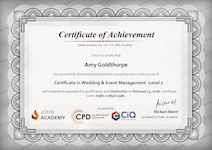Sage 50 Payroll 2017 for Beginners - CPD & IAO Accredited
John Academy
Summary
Overview
Small and medium-sized businesses are often called the backbone of the economy. Which is why they need room to grow in order to support the big businesses. But with so many aspects of a company to take care of, it can often be intimidating for owners to run it smoothly. Not to worry though, because with the help of this Sage 50 Payroll for Beginners course you will learn to use the sage 50 payroll software with ease.
This course covers many different topics and each chapter clearly states its objectives for your convenience. The sage 50 software are great for taking care of administrative tasks, which allows for you – the user – to concentrate on more important matters at hand. As the name suggests this course focuses on payroll and you can expect to learn payroll basics, managing employees, updating records & reports and so much more.
Having accurate and timely data is critical for payroll and accounts to run smoothly, which is why you should consider getting this course right now, as it will help you do just that.
CPD
Course media
Description
Course Curriculum:
Module 1: Payroll Basics – Setting up payroll, tax codes, month end, reports, keeping records, licence limitations and links to an accounts program
Module 2: Company Settings – Details, bank & coinage, absence, analysis, tax funding, statutory funding, HMRC payments, documents
Module 3: Legislation Settings – Legislation setting dialog box, PAYE, NI bands & rates, SSP, SMP/SAP/SPP/ShPP, car details, student, AEO rates, minimum wage, childcare, automatic enrolment
Module 4: Pension Scheme Basics – Pensions schemes dialog box, setting up pension scheme, pensions regulator website and the sage 50 payroll pensions module
Module 5: Pay Elements – Pay elements settings dialog box, managing payment and deduction types, loans, net payments, salary sacrifice
Module 6: The Processing Date – Changing the processing date
Module 7: Adding Existing Employees – Using quick employee, adding multiple employees, changing their status, updating year-to-date values
Module 8: Adding New Employees –Adding new employees in a variety of ways
Module 9: Payroll Processing Basics – Payroll process view, change processing dates
Module 10: Entering Payments – Entering payment window, checking and editing payments
Module 11: Pre-Update Reports – Employer costs report, payslips, BACS payments reports, figures for accounts
Module 12: Updating Records – Updating records, period end P32 report
Module 13: e-Submissions Basics – e-submissions settings, EAS, FPS, EPS
Module 14: Process Payroll (November) – Entering payments, pre-update reports, updating records, P32 reports, full payment submission
Module 15: Employee Records and Reports – Using employee record window, tabs and to find employee and their reports
Module 16: Editing Employee Records – Editing different records for employees, creating new factored pay elements, applying pay elements to employees
Module 17: Process Payroll (December) – Processing the payroll, entering payments, pre-update reports, updating records, P32 report and Full payment submission
Module 18: Resetting Payments – Introduction to reset payments wizard
Module 19: Quick SSP – Processing the payroll with SSP, entering payments, pre-update reports, updating records, P32 report and full payment submission
Module 20: An Employee Leaves – Entering payments, updating records, lever wizard, P32 report, full payment submission, rejoining employees
Module 21: Final Payroll Run – Entering payments, pre-update reports, updating records, P32 report, full payment submissions
Module 22: Reports and Historical Data – Reports window, employee, company, legislation and historical reports, historical data settings, printing historical payslips and history report by employee
Module 23: Year-End Procedures – Year end tasks, payroll year end wizard, post year-end tasks
Assessment and Certification:
Upon completion of the course, you will be required to sit an online multiple-choice test. Your test will be assessed automatically and the results will be given to you immediately. Before sitting your final exam you will have the opportunity to test your proficiency with a mock exam. After you have successfully passed the final exam, you will be able to order an Accredited Certificate of Achievement at an additional cost of £24 for a PDF copy and £39 for an original print copy sent to you by post.
Who is this course for?
- For beginners who are getting started with handling accounts.
- People who are interested in managing accounts through Sage 50 software.
Questions and answers
Do I need Sage software to complete this course?
Answer:Hi Claire, Thank you for your question. To practice what you have learnt from the course and demonstrate how well you have grasped the Sage 50 application, you may need the software. However, we do not make it a prerequisite to complete this course. Hope that answered your question. Regards, Help Desk
This was helpful.how does this work are you directly e-mailed a link or do you need to wait for it to arrive in the post? i need to know if it can be started immediat
Answer:Hi Kbr, Once you have purchased the course from Reed, an email will be sent to you with your login details to access the course. You can start/access your course immediately. Regards, Help Desk
This was helpful.
Reviews
Currently there are no reviews for this course. Be the first to leave a review.
Legal information
This course is advertised on reed.co.uk by the Course Provider, whose terms and conditions apply. Purchases are made directly from the Course Provider, and as such, content and materials are supplied by the Course Provider directly. Reed is acting as agent and not reseller in relation to this course. Reed's only responsibility is to facilitate your payment for the course. It is your responsibility to review and agree to the Course Provider's terms and conditions and satisfy yourself as to the suitability of the course you intend to purchase. Reed will not have any responsibility for the content of the course and/or associated materials.




